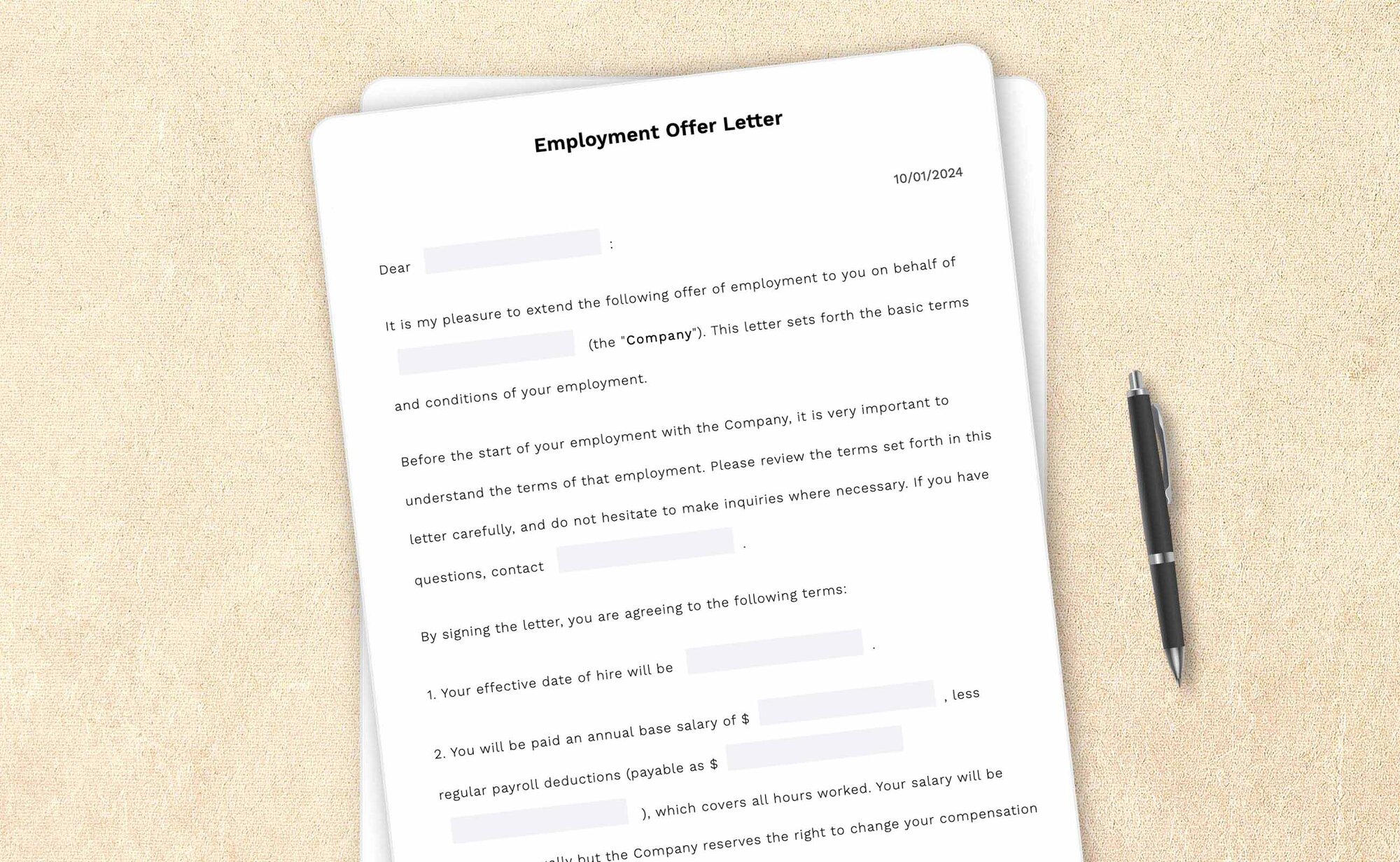Dear
It is my pleasure to extend the following offer of employment to you on behalf of
Before the start of your employment with the Company, it is very important to understand the terms of that employment. Please review the terms set forth in this letter carefully, and do not hesitate to make inquiries where necessary. If you have questions, contact
By signing the letter, you are agreeing to the following terms:
1. Your effective date of hire will be
2. You will be paid an annual base salary of $
3. Your job title will be
We look forward to having you join our team. To confirm your agreement with and acceptance of these terms, please sign one copy of this letter and return it to
| Sincerely, | |||||||||||||||||||||||||||||||
_______________________________ |
|||||||||||||||||||||||||||||||
I agree to the terms of employment set forth in this letter.
| ____________________________________________ |
| ____________________________________________ Date |
How-to guides, articles, and any other content appearing on this page are for informational purposes only, do not constitute legal advice, and are no substitute for the advice of an attorney.
Employment offer letter: How-to guide
Starting on the right foot is essential to establishing a productive, successful, and professional workplace. A prospective employee’s first impression of a company may be created by its employment offer letter. There are many advantages to a well-crafted job offer letter, the most obvious of which is the legal protection it provides a company or business.
By providing written employment terms—including details of potential compensation, position, and at-will status—the company is creating a legal letter document that, when signed, can prove valuable if disputes occur.
Additionally, a job offer letter lists employment terms, limiting later confusion and disagreement about those provisions. An express statement of those terms not only eliminates ambiguities but also establishes a working relationship built on mutual understanding.
Through this article, you'll learn the key aspects of job offer letters and essential details employers should take care of while creating a formal job offer letter.
Guidelines to follow while creating your job offer letter

Although preparing an employment offer letter is a valuable first step, the following suggestions will further protect your business and promote long-lasting employment relationships.
1. Write down essential details you want to include in your employment offer letter
Before sitting down to draft your offer letter, think about the employment relationship and the priorities you want to communicate. A good job offer letter accurately captures the company's intentions and clearly expresses them to the potential employee. This allows you to clarify the specific terms and conditions of the agreement before expressing them in writing.
2. Provide details regarding the compensation package and job position
State the salary clearly and explain how often payments will be made (weekly, bi-weekly, or monthly). Provide annual salary details and how candidates will be paid for their positions. The formal letter document should clarify whether new employees are hired for a full-time or part-time position.
Mention the job title of the candidate and the workplace location from where they should conduct their duties. Your job offer letter should also include the start date or date of joining.
If there is a qualifying period before the new hire can receive employee benefits, include that condition as well.
3. Refrain from adding unmet promises and benefits
Don’t promise raises, bonuses, or other business perks if those aren’t guaranteed. Don’t include anything that isn’t an absolute. If you have a simple bonus calculation applicable to a candidate, include that information.
4. Details on any applicable reimbursements
In case the employee is eligible for any reimbursements like moving expenses, travel or fuel expenses, food expenses, etc., add those details here.
5. Provide candidates time to review the contract
You must give time for the new employee to review the employment offer letter and understand the agreement’s terms before they sign.
6. Customize an offer letter carefully
If you customize your job offer letter to create new offer letters for future candidates, don't alter the at-will language or insert terms that conflict with that language (for example, references to long-term employment). Editing legal clauses might lead to misinterpretations and confusion.
7. The selected candidate should sign the contract to make the job offer official
Regardless of the nature of your agreement, the offer letter should be signed before the employee starts work.
8. Keep official records safe
Maintaining accurate records is essential for your company’s long-term success. All of your important documents should be kept in safe and accessible files.
9. Treat your team equally
You must be consistent and non-discriminatory in your treatment of all employees.
10. Follow applicable laws and regulations
Comply with all applicable state and federal laws all of the time. This means you can’t apply rules to some employees and not to others; no matter what employment relationship the employee has with managers or executives, all rules must be applied equally.
11. Explain company policies clearly
You should consider preparing a grievance policy/complaint policy and incorporating it into your employee handbook if you haven't already done so. Employees can use this policy to determine where to go if they have any complaints.
12. Instruct team leads in upholding company culture
Ensure all of your company’s managers and supervisors are instructed in proper managerial conduct and responsibilities. A company may be held liable for the actions of its managers in the course of business, which (win or lose) can result in extremely expensive litigation. You should ensure that your managers understand the company’s critical business policies (for example, those governing sexual harassment and access to personnel files).
13. Seek legal help in case of doubts
If you think your job offer letter is complicated and you need some legal help to create it, you can always seek the help of an attorney. Contact an attorney to help develop a contract more suited to your explicit needs.
Important details formal offer letters should have

The following instructions will help you understand the terms of your sample offer letter.
1. Introduction
Start the offer letter by providing details about the company, like the company name, and company logo (may be at the top of the document). Then provide information about the new hire, their name, and job position.
2. Start date or joining date
Insert the effective date of the candidate. This is typically the day the employee will actually begin work.
3. Compensation
Mention the payment information. Insert the employee’s annual base salary. Don't include bonus or other compensation information here. Describe the payment schedule (weekly, monthly, etc.). This should reflect your existing payroll schedule.
4. Workplace location
Add the new employee’s place of work (for example, office location and department) and duties. Be thorough when describing employee duties and mention that these duties can be changed at any time based on changing business requirements.
5. Reporting manager or supervisor
Mention the name and job title of the new employee’s supervisor. This is usually the person responsible for supervising the employee’s day-to-day work.
6. Employee handbook acknowledgment
This section asks the employee to get accustomed to the company policies and obligations. The candidate should review the employee handbook and get accustomed to the new company as soon as possible.
7. Additional information on key clauses
If the employee will sign non-disclosure, confidentiality, or invention assignment agreements, list those agreements here. These additional agreements should be signed before the start of employment.
Use a job offer letter template to save time and effort
As an employer or hiring manager, creating an employment offer letter from scratch for every new hire can be tiresome and challenging. Along with including important job details, you should be mindful not to miss out on including critical terms in your offer letter.
Hence, a job offer letter template can assist you better in creating your formal letter. LegalZoom offers a comprehensive job offer letter template to help you create your official document.
You can purchase our template for a nominal price. They are simple and easy to use. All you have to do is fill out important details, customize the template to suit your requirements with the help of a rich editor, and download your document as a .pdf file once complete.
LegalZoom also provides you with other letter templates that candidates can use to accept or reject a job offer once they get an employment offer.
Frequently asked questions
What's an employment offer letter?
When you hire a new employee, you must officially bring them up to speed and into the team. An employment offer letter will help you and your new candidate get on the same page, outlining basics from salary and pay schedules to their job title. It also outlines whether they're required to sign a non-disclosure agreement or consent form for conducting a drug test and background check. Putting a formal offer letter in place also helps settle any debates in the future.
To create a formal offer letter, you need to know:
- Who the employer is: Keep the employer's name and contact address ready
- Who the employee is: Keep the candidate’s name and contact information handy
